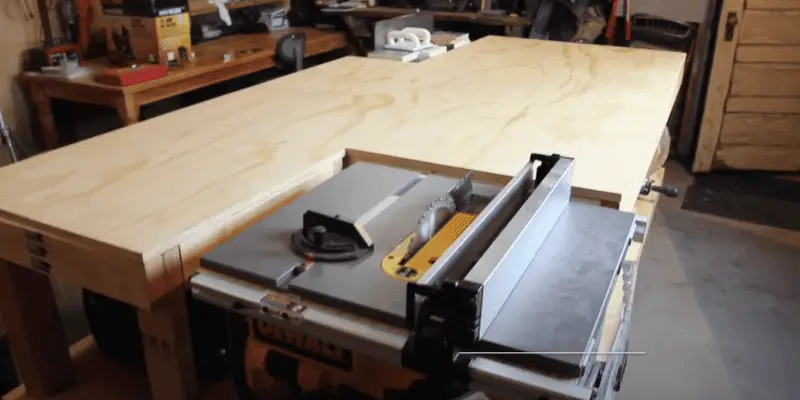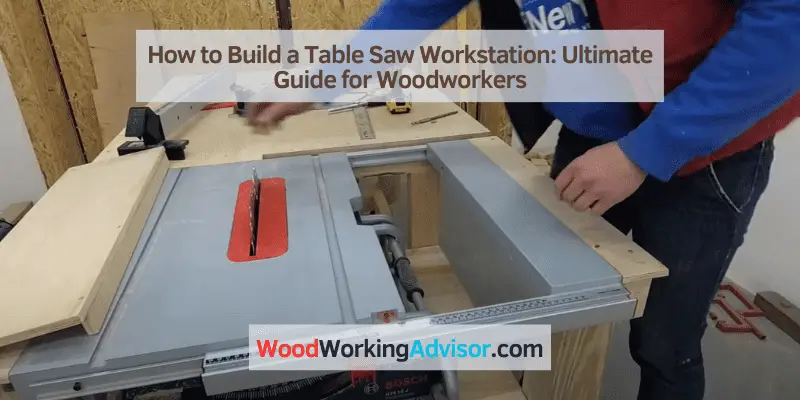To build a table saw workstation, start by ensuring a sturdy work surface and adding storage space for tools and accessories. Additionally, incorporate safety features such as a blade guard and a power switch within easy reach.
A well-rounded table saw workstation should prioritize functionality, organization, and safety. Consider incorporating features like a dust collection system, integrated power outlets, and adjustable fences to improve versatility and usability. When designing your workstation, prioritize the layout for efficient workflow, keeping essential tools and materials accessible.
Essenatially, the construction of a table saw workstation requires careful planning and attention to detail to create an efficient and safe workspace for woodworking projects.
Selecting The Perfect Table Saw
When setting up a table saw workstation, choosing the right table saw is crucial for achieving precision and efficiency in your woodworking projects. Let’s dive into the essential factors to consider when selecting the perfect table saw to fit your workstation’s needs.
Assessing Table Saw Types For Your Workstation
Before purchasing a table saw, it’s important to understand the various types available. These include benchtop, contractor, cabinet, and hybrid table saws. Each type has its own advantages and limitations, catering to different workshop setups and woodworking requirements.
Understanding Power Requirements And Table Saw Features
Power requirements vary among table saw types, so it’s crucial to assess your workspace’s electrical capacity and select a table saw that matches it. Additionally, consider features such as fence systems, dust collection, and safety mechanisms. These features play a significant role in enhancing the overall functionality and safety of your table saw workstation.
Importance Of Saw Blade Selection
Choosing the right saw blade is essential to achieve precise cuts for different woodworking tasks. Factors to consider include blade material, tooth count, and blade size. Opting for high-quality saw blades that cater to specific cutting requirements can significantly enhance the accuracy and quality of your woodworking projects.

Designing Your Workstation
Discover how to create an efficient table saw workstation to optimize your woodworking projects. Learn step-by-step techniques for designing a functional and ergonomic workstation that enhances your productivity and safety. From choosing the right materials to assembling custom storage solutions, this guide provides valuable insights for DIY enthusiasts and professional woodworkers.
Space Planning And Size Considerations
When designing a table saw workstation, consider the available space in your workshop. An efficient layout ensures that you have enough room to maneuver the material being cut and work comfortably. Measure the dimensions of the area where the workstation will be placed, allowing enough space for the table saw, work surface, and any additional storage or tools you plan to incorporate.
Ergonomics And Height Adjustments
Considering ergonomics is crucial when designing a table saw workstation. Ensure that the height of the table saw and work surface is comfortable for prolonged use. Incorporating adjustable features ensures that the workstation can be customized to suit your individual height and reach, reducing strain and fatigue during operations.
Incorporating Dust Collection Systems
An essential consideration when designing a table saw workstation is the integration of a dust collection system. Incorporating a dust collection system will help maintain a clean and safe working environment by effectively capturing sawdust and debris, preventing it from accumulating on the workspace and in the air. Include a designated area or compartment for the dust collector to streamline the cleaning process and keep the workshop tidy.
Gathering Materials And Tools
Before embarking on building a sturdy table saw workstation, it is crucial to gather the necessary materials and tools. Setting the foundation with the right building materials and equipment is essential for a smooth construction process and ensuring safety. Here’s a breakdown of the essentials you’ll require for the project.
List Of Essential Building Materials
- Plywood sheets: for constructing the main table and shelves
- 2×4 lumber: for framing the workstation and providing structural support
- Wood screws: for securing the joints and attachments
- Wood glue: for extra stability and reinforcement
- Table saw fence: for accurate and precise cutting
- Flathead screws and washers: for attaching the table saw and other components
- Leveling feet: for adjusting the workstation to ensure stability
Tool Checklist For The Workstation Construction
- Circular saw or table saw: for cutting plywood and lumber
- Power drill and drill bits: for making holes and securing screws
- Tape measure and ruler: for precise measurements
- Screwdriver set: for assembling and attaching components
Safety Equipment And Precautions
Prioritize safety during the construction process by equipping yourself with the necessary gear and adhering to precautions. This includes safety goggles, work gloves, and ear protection to safeguard against potential hazards such as sawdust and noise. Additionally, ensure the work area is well-ventilated and free from clutter to minimize risks and prevent accidents.
Preparing The Base And Frame
When building a table saw workstation, the first step is to prepare the base and frame. This foundational phase sets the stage for a sturdy, stable, and functional workspace for your table saw. The primary focus of this stage is to cut and assemble base frame components, ensure stability features and mobilizing elements are in place, and securely mount the table saw on the base.
Cutting And Assembling Base Frame Components
The base frame serves as the backbone of the workstation, providing structural support for the table saw. It is crucial to carefully measure and cut the components to the precise dimensions to ensure a snug and secure fit. Assemble the frame using sturdy fasteners, such as screws or bolts, to guarantee stability and durability. Additionally, consider adding reinforcement elements, such as corner braces, to further strengthen the frame.
Stability Features And Mobilizing Elements
Stability is essential for safe and accurate table saw operation. Incorporating features such as adjustable leveling feet or locking casters can help stabilize the workstation on uneven surfaces, preventing wobbling or tipping during use. Moreover, adding mobility elements, such as swivel casters or wheels, enables easy movement and repositioning of the workstation within the workshop space.
Mounting The Table Saw Securely On The Base
Securing the table saw to the base is critical for safe and efficient operation. Use appropriate mounting hardware and brackets to firmly attach the table saw to the base, ensuring that it remains stationary during use. Consider incorporating vibration-dampening materials, such as rubber pads, between the table saw and the base to minimize unwanted movement and noise while cutting.

Custom Workstation Features
When it comes to creating a table saw workstation tailored to your specific needs, the custom workstation features play a pivotal role. With meticulous attention to detail, you can incorporate various elements that enhance functionality and efficiency. From clever storage solutions to support wings, the custom features of your workstation can significantly elevate your woodworking experience.
Adding Storage Solutions And Tool Organizers
Storage is a critical aspect of any woodworking setup. Maximizing the space available in your table saw workstation can help keep your workspace clutter-free and increase productivity. By incorporating custom-built cabinets, drawers, and shelves, you can organize your tools, safety gear, and essential supplies efficiently. Utilizing retractable holders for frequently used tools and magnetic strips for small items can further optimize the available space.
Installing Outfeed Tables And Support Wings
Outfeed tables and support wings are invaluable additions to a table saw workstation, providing stability and precision during cutting operations. Integrating adjustable outfeed tables enhances the versatility of your workstation, accommodating large panels and long boards with ease. Additionally, installing removable support wings with adjustable height and extensions enables seamless handling of various workpieces, ensuring optimal support throughout the cutting process.
Final Touches: Measuring Tools And Accessories
Completing your custom table saw workstation involves equipping it with essential measuring tools and accessories. Consider integrating a dedicated measuring tape holder for quick access and storage racks for various guides and jigs. Implementing dust collection systems and overhead lighting fixtures can enhance visibility and maintain a clean workspace. Furthermore, employing custom-made push sticks and safety guards ensures safe and efficient woodworking practices.
Frequently Asked Questions For How To Build A Table Saw Workstation
What Are The Essential Features Of A Table Saw Workstation?
A table saw workstation should have a sturdy build, ample workspace, integrated storage, a fence system, and a dust collection mechanism. The workstation should be designed to maximize safety, efficiency, and precision for woodworking projects.
How Can I Optimize The Space In A Small Workshop With A Table Saw Workstation?
In a small workshop, you can optimize space by customizing the workstation to fit the available area, utilizing wall-mounted storage solutions, and incorporating foldable elements. It’s important to prioritize functionality while ensuring the workstation doesn’t impede movement within the workshop.
What Safety Measures Should Be Considered When Using A Table Saw Workstation?
When using a table saw workstation, always wear appropriate safety gear, maintain a clutter-free workspace, use push sticks for narrow cuts, and ensure the blade guard and riving knife are in place. Remember to disconnect power when making adjustments and follow proper usage techniques to prevent accidents.
How Do I Maintain And Prolong The Lifespan Of My Table Saw Workstation?
Regular maintenance such as cleaning the table surface, lubricating moving parts, inspecting the electrical components, and aligning the fence and blade, can help prolong the lifespan of your table saw workstation. Additionally, using quality blades and regularly checking for wear and tear is essential for longevity.
Conclusion
Building a table saw workstation can greatly enhance your woodworking experience. By following the step-by-step guide, you can create a functional and organized space, increasing efficiency and safety in your workshop. Consider customizing the design to fit your specific needs and tools.
With dedication and patience, you can create a workstation that will support your woodworking projects for years to come.


